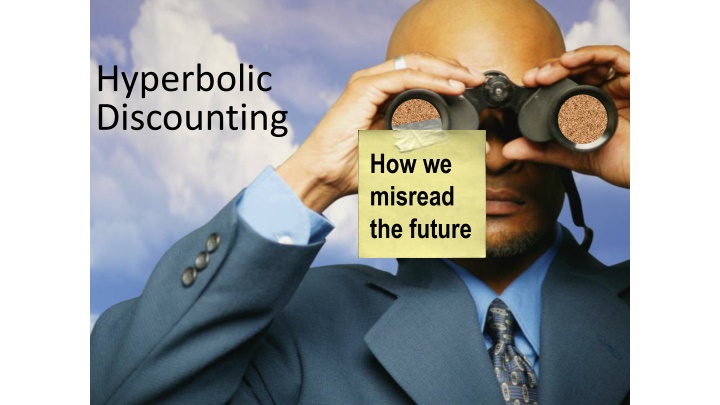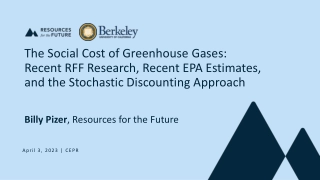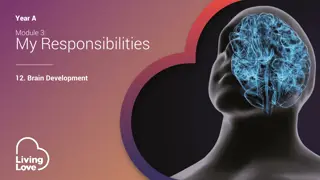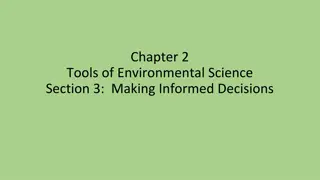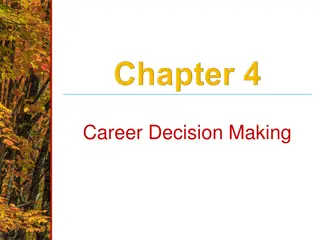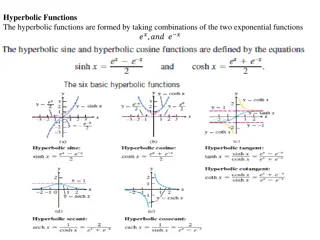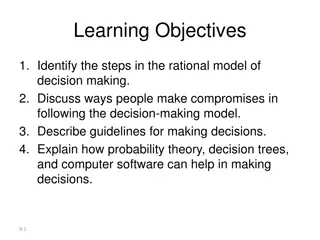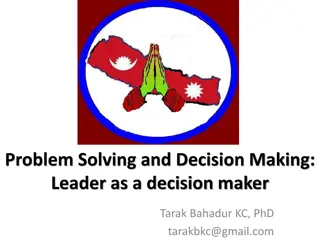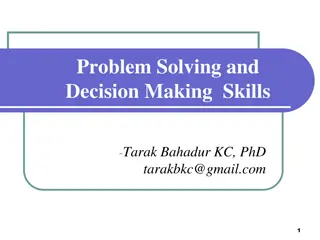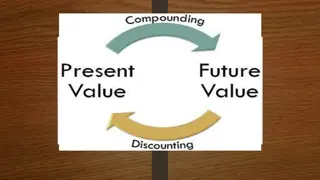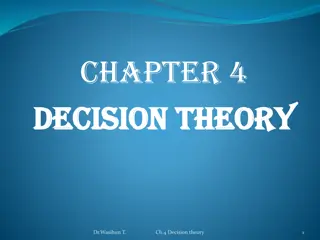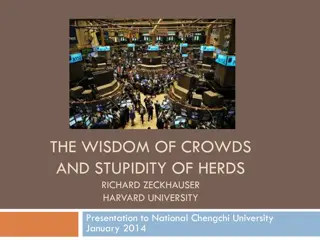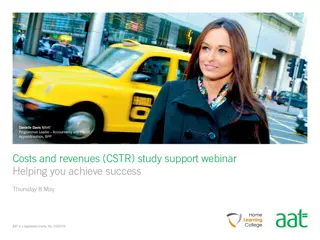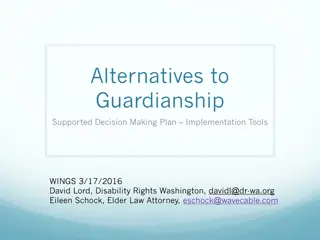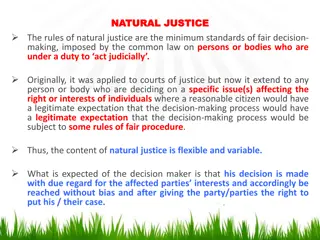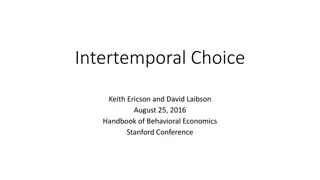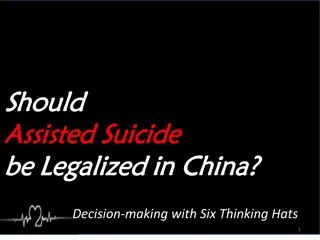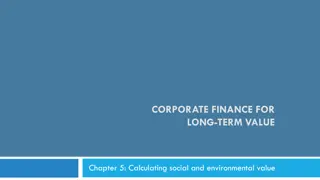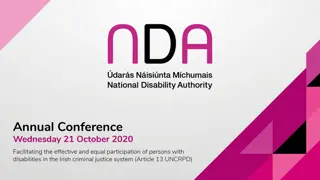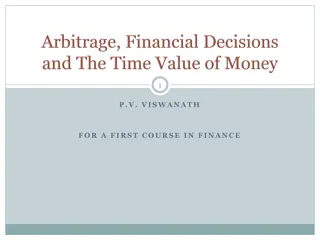Hyperbolic Discounting and Impatience in Decision Making
This content delves into the concept of hyperbolic discounting, explaining how individuals often prioritize present happiness over future rewards. It explores examples of discount rates, comparing the patience levels of individuals like Alice and Bob. The discussion leads to insights on patience, impatience, and rational decision-making.
Download Presentation

Please find below an Image/Link to download the presentation.
The content on the website is provided AS IS for your information and personal use only. It may not be sold, licensed, or shared on other websites without obtaining consent from the author.If you encounter any issues during the download, it is possible that the publisher has removed the file from their server.
You are allowed to download the files provided on this website for personal or commercial use, subject to the condition that they are used lawfully. All files are the property of their respective owners.
The content on the website is provided AS IS for your information and personal use only. It may not be sold, licensed, or shared on other websites without obtaining consent from the author.
E N D
Presentation Transcript
Hyperbolic Discounting How we misread the future
Reading Predictably Irrational, Chapter 6, The Influence of Arousal Predictably Irrational, Chapter 7, The Problem of Procrastination and Self-Control Nudge, Chapter 2, Resisting Temptation
Discounting Being happy now (today, this week, this year) is typically more desirable than the prospect of being happy in the future (tomorrow, next week, next year) Suppose happiness during a time period (day, week, year) can be measured The discount rate is the additional future happiness that can compensate for the loss of one unit of happiness in the present
Discounting Example: For Alice, suppose the loss of one unit of present happiness can be compensated by the gain of 1.07 units of future happiness In this case, Alice s discount rate is 0.07 For Bob, suppose the loss of one unit of present happiness can be compensated by the gain of 1.02 units of future happiness Bob s discount rate is 0.02 Who is more patient, Alice or Bob?
Discounting Example: For Alice, suppose the loss of one unit of present happiness can be compensated by the gain of 1.07 units of future happiness In this case, Alice s discount rate is 0.07 For Bob, suppose the loss of one unit of present happiness can be compensated by the gain of 1.02 units of future happiness Bob s discount rate is 0.02 Who is more patient, Alice or Bob?
Discounting The higher your discount rate, the more important the present is to you (relative to the future) The higher your discount rate, the more impatient you are
Patience-Impatience Bob has a lower discount rate than Alice This means Alice gives more importance to her present relative to her future than Bob does Informally, we can say that Alice is less patient than Bob But this does not make Alice less moral than Bob Just as ignoring the future is not a good thing, neither is ignoring the present
Patience-Impatience Standard economics doesn t say that all rational people are patient or that all rational people are impatient Standard economics understands that some people are patient and others are impatient, and being rational has nothing to do with patience or impatience The clash between standard economics and behavioral economics arises over the phenomenon of hyperbolic discounting or dynamic inconsistency
Dynamic Inconsistency Typically, when we are making plans about what we d do in the future, we are patient our discount rates are low But when the future finally arrives, we become impatient and succumb to temptation our discount rates spike This phenomenon is called hyperbolic discounting or dynamic inconsistency
Dynamic Inconsistency Dynamic inconsistency is a problem because it makes it difficult for us to stick to our plans In most cases, we abandon our plans because our discount rates are much higher when it is time to act than when it is time to plan But in theory our discount rates could be much lower when it is time to act than when it is time to plan. And even in this case, we would abandon our plans when it is time to act.
Dynamic Inconsistency When we think about what we d do in the future, we tend to make well thought out plans But when the future finally arrives, we give in to temptation and abandon the plans we had made Standard economics ignores dynamic inconsistency Behavioral economics emphasizes dynamic inconsistency
Patience-Impatience Dynamic inconsistency is not the same thing as being impatient or patient One can be: Consistently patient or Consistently impatient or Dynamically inconsistent Only the third group is unable to stick to its plans
Does the future me want different things? Choose among 24 movie videos Some are low brow Some are high brow schindler1 Does my choice depend on whether I am picking for tonight, next Thursday, or the following Thursday? Reed, Lowenstein & Kalyanaraman (1999) Mixing virtue and vice: Combining the immediacy effect and the diversification heuristic. Journal of Behavioral Decision Making, 12, 257-273.
Does the future me want different things? Did people choose a) More low brow movies now, more high brow movies for later b) More high brow movies now, more low brow movies for later c) About the same regardless of whether picking for now or later schindler1 Reed, Lowenstein & Kalyanaraman (1999) Mixing virtue and vice: Combining the immediacy effect and the diversification heuristic. Journal of Behavioral Decision Making, 12, 257-273.
Next week I will want things that are good for me Low Brow, 37% Low Brow, 29% High Brow, 44% High Brow, 71% Low Brow, 56% High Brow, 63% Choosing for tonight Choosing for next Thursday Choosing for second Thursday Reed, Lowenstein & Kalyanaraman (1999) Mixing virtue and vice: Combining the immediacy effect and the diversification heuristic. Journal of Behavioral Decision Making, 12, 257-273.
Does the future me want different things? When choosing between a healthy and unhealthy snack for delivery in one week, do people systematically misproject future desires? Next Week Predicted preference Right Now Actual preference D. Read (Leeds U.) & B. van Leeuwen (Leeds U.), 1998, Predicting hunger: The effects of appetite and delay on choice. Organizational behavior and human decision processes, 76, 189-205.
Does the future me want different things? Are people a) More likely to choose the unhealthy snack for next week b) More likely to choose the unhealthy snack for right now c) About as likely either way Next Week Predicted preference Right Now Actual preference D. Read (Leeds U.) & B. van Leeuwen (Leeds U.), 1998, Predicting hunger: The effects of appetite and delay on choice. Organizational behavior and human decision processes, 76, 189-205.
Does the future me want different things? 26% chose the unhealthy snack for delivery in one week right after lunch. Next Week Predicted preference 74% 26% D. Read (Leeds U.) & B. van Leeuwen (Leeds U.), 1998, Predicting hunger: The effects of appetite and delay on choice. Organizational behavior and human decision processes, 76, 189-205.
Does the future me want different things? One week later, when allowed to change their choice at the delivery, 70% chose the unhealthy snack for immediate consumption Next Week Predicted preference Right Now Actual preference 74% 26% 30% 70% D. Read (Leeds U.) & B. van Leeuwen (Leeds U.), 1998, Predicting hunger: The effects of appetite and delay on choice. Organizational behavior and human decision processes, 76, 189-205.
Hyperbolic Discounting This is an example of under-rating the intensity of future desires
Hyperbolic Discounting, Measured Evidence suggests that discounting is steeper in the immediate future than in the further future. In one study, the median subject is indifferent between $15 now and $20 in one month (for an annual discount rate of 345 percent) and between $15 now and $100 in ten years (for an annual discount rate of 19 percent).
Hyperbolic Discounting When evaluating outcomes in the distant future, individuals are patient and make plans to exercise, stop smoking, and look for a better job. As the future gets near, the discounting gets steep, and the individuals engage in binge eating, light another (last) cigarette, and stay put on their job. Preferences with these features therefore induce dynamic inconsistency.
Gym Memberships In one study, three U.S. health clubs offered a choice between a monthly contract with lump sum fee of approximately $80 per month and no payment per visit, and a pay-per-visit contract with fee of $10. Health club users that choose the monthly contract attend only 4.4 times per month. These users pay $17 per visit even though they could pay $10 per visit
Homework and Deadlines The subjects are fifty-one professionals enrolled in a section of a semester-long executive education class at Sloan (MIT), with three homeworks as a requirement. At the beginning of the semester, they set binding deadlines (with a cost of lower grades for delay) for each of the homeworks.
Homework and Deadlines According to the standard model, they should set deadlines for the last day of the semester: There is no benefit to setting early deadlines, since they do not receive feedback on the homeworks, and there is a cost of lower flexibility. A maximization without constraints is always preferable to one with constraints.
Homework and Deadlines According to a model of self-control, instead, the deadlines provide a useful commitment device. A commitment device is a restriction on our future ability to break plans made in the past. Setting early deadlines would make it costly for us to break our plans to do the homework in a timely manner. So setting early deadlines would serve as a commitment device.
Homework and Deadlines Homework completion is an investment good That is the pain comes before the reward So, breaking plans and delaying doing the homework becomes tempting The results supported the self-control model: 68 percent of the deadlines were set for weeks prior to the last week, indicating a demand for commitment.
Homework and Deadlines This result leaves open two issues. First, do the self-set deadlines improve performance relative to a setting with no deadlines? Second, are the deadlines set in an optimal or efficient manner? Do we fully understand that we lack self-control? Do we underestimate the need for commitment devices?
Homework and Deadlines In a second (laboratory) experiment, sixty students complete three proofreading assignments within twenty-one days. The control group can turn in each assignment at any time within the twenty-one days A first treatment group can choose three deadlines (as in the class-room setting described earlier), and A second treatment group faces equal-spaced deadlines.
Homework and Deadlines The first result is that self-set deadlines indeed improve performance: The first treatment group does significantly better than the control group, detecting 50 percent more errors (on average, 105 versus 70) and earning substantially more as a result (on average, $13 versus $5).
Homework and Deadlines The second result is that deadline setting is not optimal: the group with equal-spaced deadlines does significantly better than the other groups, on average detecting 130 errors and earning $20. This provides evidence that we underestimate our self-control problems.
Credit Card Offers Borrowers were offered two types of credit card contracts: 1. Low teaser interest rate for first six months, followed by high post- teaser interest rate after the first six months 2. Higher teaser rate, followed by lower post-teaser rate Borrowers went for the first contract even though, given their borrowing behavior, they would have been better off with the second
In the future, I expect to prefer the long-term, rational choice. When the future becomes right now, I prefer the pleasurable choice! [hyperbolic discounting] Later v. Now
In the future, I expect to prefer the long-term, rational choice and quit smoking. When the future becomes right now, I keep smoking. Hyperbolic discounting with smoking?
Self-predicted future behavior in teenage smoking 15% of light smokers (less than one cigarette per day) in high school predicted they might be smoking in 5 years. 15% predicted 5 years later, what percentage were still smoking? a) Less than 5% b) 5% to 15% c) About 15% d) 15% to 30% e) Greater than 30% L. Johnston (U. Michigan), P. O Malley (U. Michigan), J. Bachman (U. Michigan), 1993, Illicit drug use, smoking, and drinking by America s high school students, college students, and young adults, 1975-1987. National Institute on Drug Abuse: Rockville, Maryland.
Self-predicted future behavior in teenage smoking 15% of light smokers (less than one cigarette per day) in high school predicted they might be smoking in 5 years. 15% predicted 43% actual 5 years later, 43% were still smoking. L. Johnston (U. Michigan), P. O Malley (U. Michigan), J. Bachman (U. Michigan), 1993, Illicit drug use, smoking, and drinking by America s high school students, college students, and young adults, 1975-1987. National Institute on Drug Abuse: Rockville, Maryland.
Emotions Hyperbolic discounting may be more likely when people find themselves in an emotionally aroused state
Economic Consequences of Hyperbolic Discounting Excessive spending, inadequate saving (especially for retirement), bankruptcy, and debt default Inadequate personal investment in education National neglect of investment on infrastructure, public education, scientific research Excessive national spending on wars and other trivial issues that have immediate appeal
Sometimes we find it difficult to stick to a plan because we made the plan when we were in an unusual situation PROJECTION BIAS
Projection Bias Hyperbolic discounting is not the only kind of systematically incorrect prediction that we are prone to There s also projection bias
Projection Bias Projection bias supposes that people believe they will value options in the future the way they value them today. They tend to ignore the impact of some factors that should change in the intervening time. This explains why we find it difficult to stick to a plan
Projection Bias: our current state (hot v. cold) influences projections of our future desires. Cold v. Hot
Does the current state of hunger change which snack people will order for delivery next week? a) Yes, hungry people choose the unhealthy snack b) Yes, hungry people choose the healthy snack c) No
Projection of future preferences depends on our current state I m not hungry right now, so next week I will prefer the healthy snack. People asked right after lunch (not hungry), chose the unhealthy snack for delivery in one week right after lunch 42% of the time. People asked four hours after lunch (hungry), chose the unhealthy snack for delivery in one week right after lunch I m hungry, so next week I will prefer the candy bar. 78% of the time Cold v. Hot
Cold v. Hot Projection bias Cold state projects to future cold state I m not hungry right now, so next week I will prefer the healthy snack just like I do right now. Hot state projects to future hot state I m hungry, so next week I will prefer the unhealthy choice just like I do right now.
Return rates of cold weather items Conlin, O Donoghue, and Vogelsang (2007) find that a reduction in the order date temperature of 30 F corresponding to a decrease, for example, from 40 F to 10 F increases the average return rate of a cold-weather item by 3.96 percent, consistent with projection bias.
An experiment with heroin addicts Heroin addicts in treatment receive a replacement drug. It produces a mild high designed to ward off heroin cravings. A double-dose produces a longer, more intense high. Choice between money or a double-dose, either to be received in five days. G. Badger (U. Vermont), W. Bickel (U. Arkansas), L . Giordano (Duke), E. Jacobs (S. Illinois U.), G. Loewenstein (Carnegie Mellon), L. Marsch (St. Luke s Hospital, NY), 2007, Altered states: The impact of immediate craving on the valuation of current and future opiods. The Journal of Health Economics, 26, 865-876.
Projection bias predicts that heroin addicts a) Would forego more money for the promise of an extra dose in 5 days if they were currently craving. b) Would forego less money for the promise of an extra dose in 5 days if they were currently craving. c) Would forego more money for an immediate extra dose than for one in 5 days. d) The state of craving would make no impact because they don t get the extra dose for 5 more days.
$70 $60 $50 Amount of future money willing to give up for double- dose in 5 days $40 $30 $20 $10 $0 Before regular dose After regular dose When in a COLD state, I act as if I will always be in a COLD state. When in a HOT state, I act as if I will always be in a HOT state.
I need a hit now, so next week I will prefer an extra dose to $50. I don t need drugs now, so next week I will prefer $50 to an extra dose. $70 $60 Amount of future money willing to give up for double- dose in 5 days $50 $40 So, for therapists, it might be a good idea to offer cash incentives for future good behavior when the addict is not craving drugs. $30 $20 $10 $0 Before regular dose After regular dose
